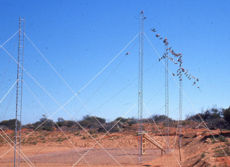Riometer
Back to Station Equipment
The Relative Ionospheric Opacity Meter (Riometer) installed at SPAN in mid-1966 was essentially a wide-angle radio telescope monitoring cosmic radiation - background radio noise at around 30Mhz emitted from distant stars and galaxies - by observing its effect on the opacity of the ionospere.
Our ionospere partially absorps some of the cosmic radiation. A 'quiet-day curve' of the background noise with its regular diurnal variations is first established. Any rapid dip in the 'quiet-day curve' can be attributed to external events affecting the opacity of the ionosphere, such as proton showers from the Sun or radiation released from the atmospheric testing of nuclear explosions; both potentially dangerous to astronauts. The Riometer antenna was pointed towards the south magnetic pole because the opacity effect was most obvious there.
The Antenna was one of the most unusual at Carnarvon consisting of a ‘book-fold corner reflector’ made from backyard materials. Each face of the ‘book’ was approximately 75m by 30m. The total surface area was the largest of any on the site but otherwise it was relatively inconspicuous. The horizontal ground-plane was chook-wire. Perpendicular to it along the long edge was a vertical screen of masts braced by Dacron guy ropes and supporting horizontal single-strand 10-gauge copper wires at 30 cm intervals forming the back-plane. An Oregon-pine ‘gate’ supported a central horizontal dipole antenna at about 2.5m above the ground plane and 2.5m in front of the rear screen.
Shortly after construction, a male emu took to strolling on the chook-wire ground-plane of the Riometer antenna, lifting the wire with every step he took. The SPAN crew tried to shoo the emu away, but he went crazy and tore up the wire which then rolled up and imprisoned him. After the enraged emu was released the chook-wire was re-laid; thereafter the crew let him stroll as he wished.
It was also not long before the local cockatoos discovered that the narrowly-spaced copper wires of the antenna back-plane were a wonderful gymnasium; they sliced through them as they spun around the wires on their beaks. The wires were replaced by braided-copper steel-core cable,

